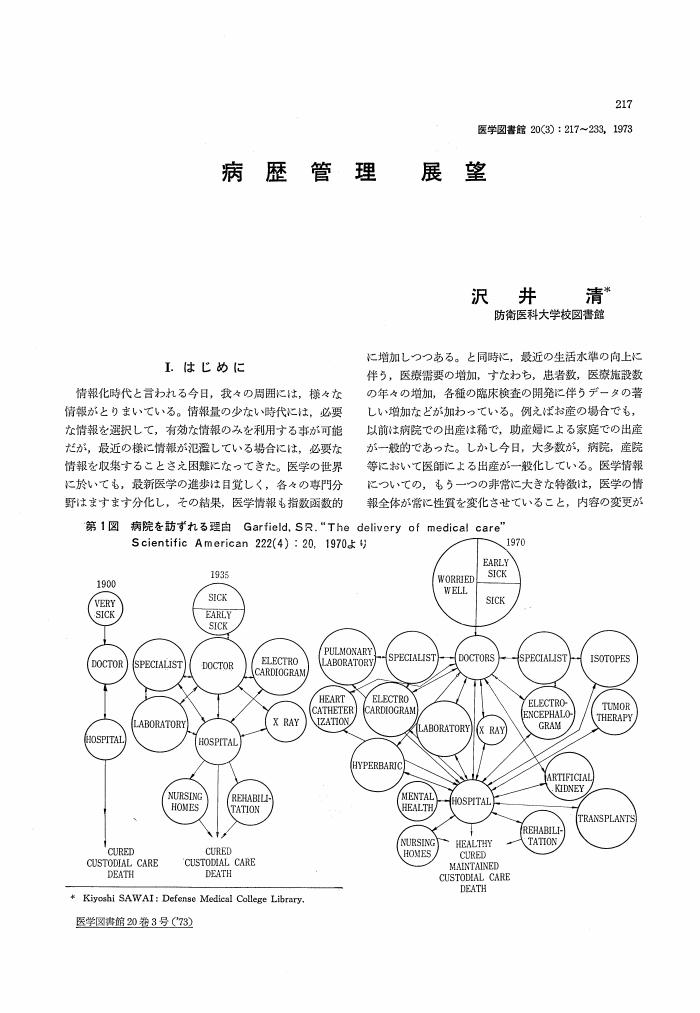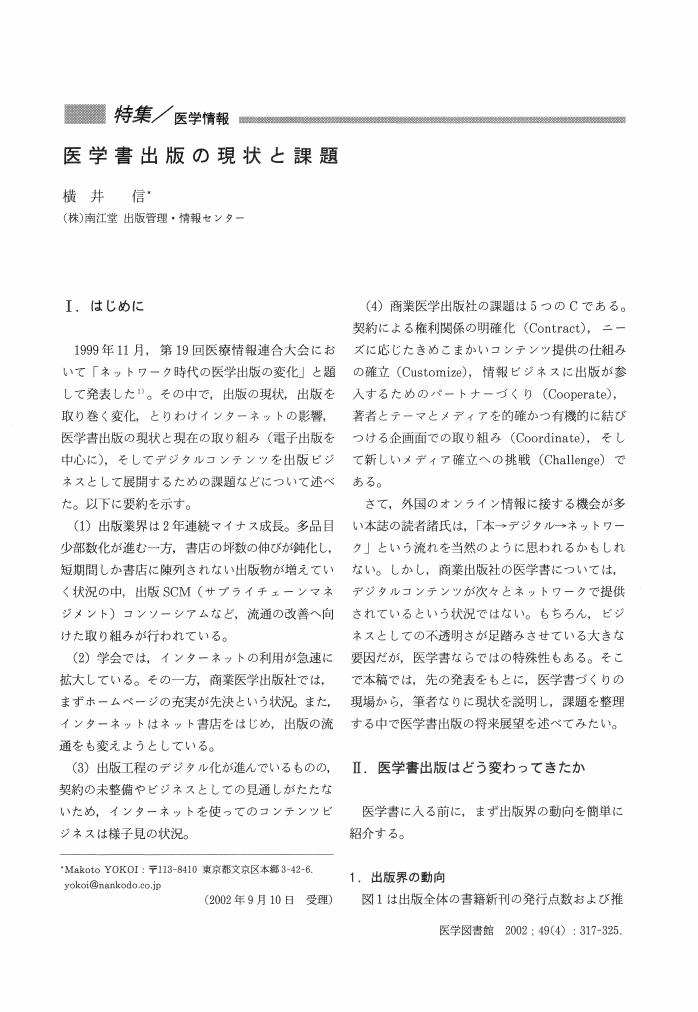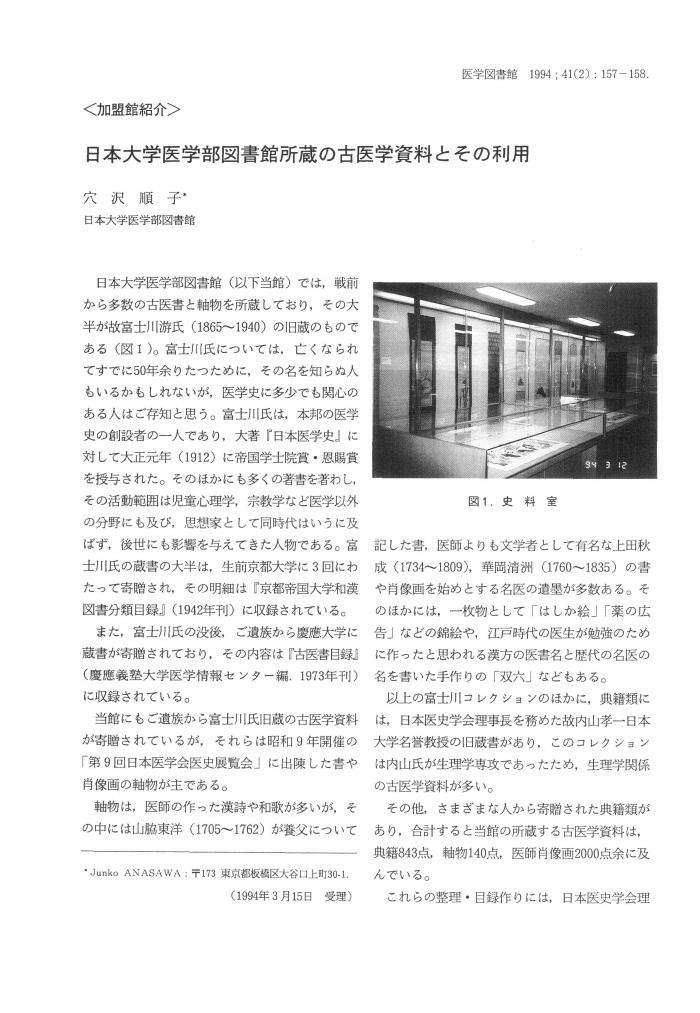1 0 0 0 病院図書室コンサルタント・マニュアル
- 著者
- 朴木 貞子
- 出版者
- 特定非営利活動法人 日本医学図書館協会
- 雑誌
- 医学図書館 (ISSN:04452429)
- 巻号頁・発行日
- vol.23, no.2, pp.91-95, 1976
1 0 0 0 OA 『解体新書』その2 翻訳
- 著者
- 酒井 シヅ
- 出版者
- 特定非営利活動法人 日本医学図書館協会
- 雑誌
- 医学図書館 (ISSN:04452429)
- 巻号頁・発行日
- vol.32, no.4, pp.345-346, 1985-12-25 (Released:2011-09-21)
1 0 0 0 OA 解體新書と蘭学の発展
- 著者
- 小川 鼎三
- 出版者
- 特定非営利活動法人 日本医学図書館協会
- 雑誌
- 医学図書館 (ISSN:04452429)
- 巻号頁・発行日
- vol.24, no.1-2, pp.4-13, 1977 (Released:2011-09-21)
- 著者
- 菅 修一
- 出版者
- 日本医学図書館協会
- 雑誌
- 医学図書館 = Journal of the Japan Medical Libraries Association (ISSN:04452429)
- 巻号頁・発行日
- vol.68, no.1, pp.64-67, 2021-03
1 0 0 0 日本の鬼の交流博物館令和2年秋季特別展「鬼と疫病」見学報告
- 著者
- 菅 修一
- 出版者
- 日本医学図書館協会
- 雑誌
- 医学図書館 = Journal of the Japan Medical Libraries Association (ISSN:04452429)
- 巻号頁・発行日
- vol.68, no.1, pp.59-61, 2021-03
- 著者
- 澤井 清 清水 勝嘉
- 出版者
- 特定非営利活動法人 日本医学図書館協会
- 雑誌
- 医学図書館 (ISSN:04452429)
- 巻号頁・発行日
- vol.25, no.3, pp.123-129, 1978
本稿は, 開国後の来日宣教医および来日アメリカ人医師の第1号であるヘボンが本国に送った書簡を中心に, 彼が行った救療事業について述べたものである。ヘボンが行った救療事業は, キリスト教宣教の手段であった。ヘボンは1861年4月から9月までの神奈川宗興寺における6ヶ月間と, さらに1862年12月に横浜の居留地39番に居を移してから1879年春までの合計18年間, 救療事業を行った。ヘボンの書簡の中に記されている内容は幕末・維新期にかけてのわが国の民衆の疾病状況あるいはヘボン自身が行った手術などを詳細に知らせてくれる。ヘボンの行った救療事業は完全無料であり, 当時わが国に欠けていた社会事業を補完するものと考えてよい。
- 著者
- 菅 修一
- 出版者
- 日本医学図書館協会
- 雑誌
- 医学図書館 = Journal of the Japan Medical Libraries Association (ISSN:04452429)
- 巻号頁・発行日
- vol.67, no.4, pp.275-277, 2020-12
1 0 0 0 OA 病歴管理展望
- 著者
- 沢井 清
- 出版者
- 特定非営利活動法人 日本医学図書館協会
- 雑誌
- 医学図書館 (ISSN:04452429)
- 巻号頁・発行日
- vol.20, no.3, pp.217-233, 1973-09-01 (Released:2011-09-21)
- 参考文献数
- 21
1 0 0 0 OA 尼子四郎と夏目漱石
- 著者
- 斎藤 晴惠
- 出版者
- 特定非営利活動法人 日本医学図書館協会
- 雑誌
- 医学図書館 (ISSN:04452429)
- 巻号頁・発行日
- vol.53, no.1, pp.60-64, 2006-03-20 (Released:2011-09-21)
- 参考文献数
- 22
- 被引用文献数
- 2 1
Dr. Shiro Amako began practicing medicine in Sendagi, Tokyo in 1903. In March of that year, he first published Japana Centra Revuo Medicina (known officially in Japan as Igaku Chuo Zasshi and colloquially as Ichushi). Japana Centra Revuo Medicina is the second oldest medical abstract publication currently in existence. The Index Medicus, first published in the United States in 1879, is the oldest. Dr. Amako is well-known in Japanese medical circles for his pioneering work that contributed so much to Japanese medicine. Soseki Natsume returned to Japan from an extended period of study in England in January 1903. In March 1903, he began living in Sendagi near Dr. Amako. Soseki (the author is generally known by his given name rather than his family name in both Japan and the United States) launched his career as a novelist with I Am A Cat in 1905. This novel continues to be widely read in Japan and has been translated into many languages. One of the characters in I Am A Cat is Dr. Amaki. The fictional Dr. Amaki is said to be based on the real-life Dr. Amako. Recent scholars have placed increasing emphasis on this fact. Great achievement in both medicine and literature took place in Sendagi in the early years of the 20th century. There was a complex relationship between Soseki and Dr. Amako. Starting as a doctor/patient connection, it grew into a deep personal friendship involving not only the author and the doctor but members of their extended families as well.
- 著者
- 星野 卓之
- 出版者
- 日本医学図書館協会
- 雑誌
- 医学図書館 = Journal of the Japan Medical Libraries Association (ISSN:04452429)
- 巻号頁・発行日
- vol.67, no.1, pp.24-27, 2020-03
1 0 0 0 OA 医学書出版の現状と課題
- 著者
- 横井 信
- 出版者
- 特定非営利活動法人 日本医学図書館協会
- 雑誌
- 医学図書館 (ISSN:04452429)
- 巻号頁・発行日
- vol.49, no.4, pp.317-325, 2002-12-20 (Released:2011-09-21)
- 参考文献数
- 11
1 0 0 0 OA 日本大学医学部図書館所蔵の古医学資料とその利用
- 著者
- 穴沢 順子
- 出版者
- 特定非営利活動法人 日本医学図書館協会
- 雑誌
- 医学図書館 (ISSN:04452429)
- 巻号頁・発行日
- vol.41, no.2, pp.157-158, 1994-06-20 (Released:2011-09-21)
- 著者
- 菅 修一
- 出版者
- 日本医学図書館協会
- 雑誌
- 医学図書館 = Journal of the Japan Medical Libraries Association (ISSN:04452429)
- 巻号頁・発行日
- vol.67, no.2, pp.128-130, 2020-06
1 0 0 0 OA 富士川文庫について
- 著者
- 古原 雅夫
- 出版者
- 特定非営利活動法人 日本医学図書館協会
- 雑誌
- 医学図書館 (ISSN:04452429)
- 巻号頁・発行日
- vol.19, no.3, pp.261-264, 1972-09-01 (Released:2011-09-21)
富士川文庫は富士川游博士が大正6年に寄贈されたものである。富士川博士が資料を蒐集される過程には多くの困難性がともなっていた。辛苦の末蒐集された資料は,「日本医学史」が大成されるための前提条件であった。先生は図書館に関しても深い関心を持たれ,「図書館雑誌」に論文を掲載されたり図書館の建設にも尽力されている。文庫の特色は (1) 明治以前の和漢の医書, (2) 江戸中期以降の主として幕末期西洋医学の翻訳書, (3) わが国に関するものとしては平安朝より明治期までの医書である。文庫中のいくつかを挙げると,「続添鴻宝秘要抄」「家伝通外方」「延寿撮要」「頓医書」「啓迪集」「和蘭全躯内外分合図」「蘭学階梯」「重訂解体新書」などがある。
- 著者
- 菅 修一
- 出版者
- 日本医学図書館協会
- 雑誌
- 医学図書館 = Journal of the Japan Medical Libraries Association (ISSN:04452429)
- 巻号頁・発行日
- vol.67, no.1, pp.40-42, 2020-03
1 0 0 0 OA 資料紹介
- 著者
- 明治葉科大 東京慈恵会医科大学医学情報センター
- 出版者
- 特定非営利活動法人 日本医学図書館協会
- 雑誌
- 医学図書館 (ISSN:04452429)
- 巻号頁・発行日
- vol.33, no.2, pp.208-209, 1986-06-25 (Released:2011-09-21)
1 0 0 0 OA 「第75回NPO法人日本医学図書館協会総会」報告
- 著者
- 小川 弓子
- 出版者
- 特定非営利活動法人 日本医学図書館協会
- 雑誌
- 医学図書館 (ISSN:04452429)
- 巻号頁・発行日
- vol.51, no.4, pp.373-376, 2004-12-20 (Released:2011-09-21)
- 著者
- 菅 修一
- 出版者
- 日本医学図書館協会
- 雑誌
- 医学図書館 = Journal of the Japan Medical Libraries Association (ISSN:04452429)
- 巻号頁・発行日
- vol.66, no.2, pp.124-126, 2019-06
1 0 0 0 OA ステップマップによる薬理学・薬学雑誌の引用関係
- 著者
- 曹 錦丹 山崎 茂明
- 出版者
- 特定非営利活動法人 日本医学図書館協会
- 雑誌
- 医学図書館 (ISSN:04452429)
- 巻号頁・発行日
- vol.42, no.2, pp.204-209, 1995-06-20 (Released:2011-09-21)
- 参考文献数
- 5
- 被引用文献数
- 2 1
The two-step model was developed by F. Narin. The two-step model shows the interrelationships among scientific journals in a given subject field. This map of the interrelationships is used by research investigators in deciding which journal they will submit their papers to and also by medical libraries in evaluating their journal collection. The authors surveyed the relationships among individual journals in the fields of pharmacology and pharmacy. The major titles in the field are clearly shown and subfields were also identified by this method.
1 0 0 0 OA 医学におけるエポニミー現象に関する研究
- 著者
- 青木 仕
- 出版者
- 特定非営利活動法人 日本医学図書館協会
- 雑誌
- 医学図書館 (ISSN:04452429)
- 巻号頁・発行日
- vol.35, no.4, pp.219-227, 1988 (Released:2011-09-21)
- 参考文献数
- 15
Eponymy is the practice of affixing a scientist's name to his or her discovery or invention.Five hundred fifty-nine eponyms were analyzed from among three hundred ninety one cases selected from lists of syndromes which appeared in the Supplment of “The Japanese Journal of Clinical Medicine” in 1977 and 1982 and 1987.The following results were obtained:1) Eponyms were the most frequent (85) in the 1950's. The frequency of eponyms increased markedly from 11 in the 1870's to the 1950's but has been decreasing since then.2) Eponyms were the most frequent-179 (32%)-in the U. S. A.3) From the basis of the numbers of eponyms, the center of world medical science seems to have moved from England to France, Germany, and the U. S. A. in the 20th century.4) In Japan 2 eponyms appeared for the first time between 1901 and 1920.






